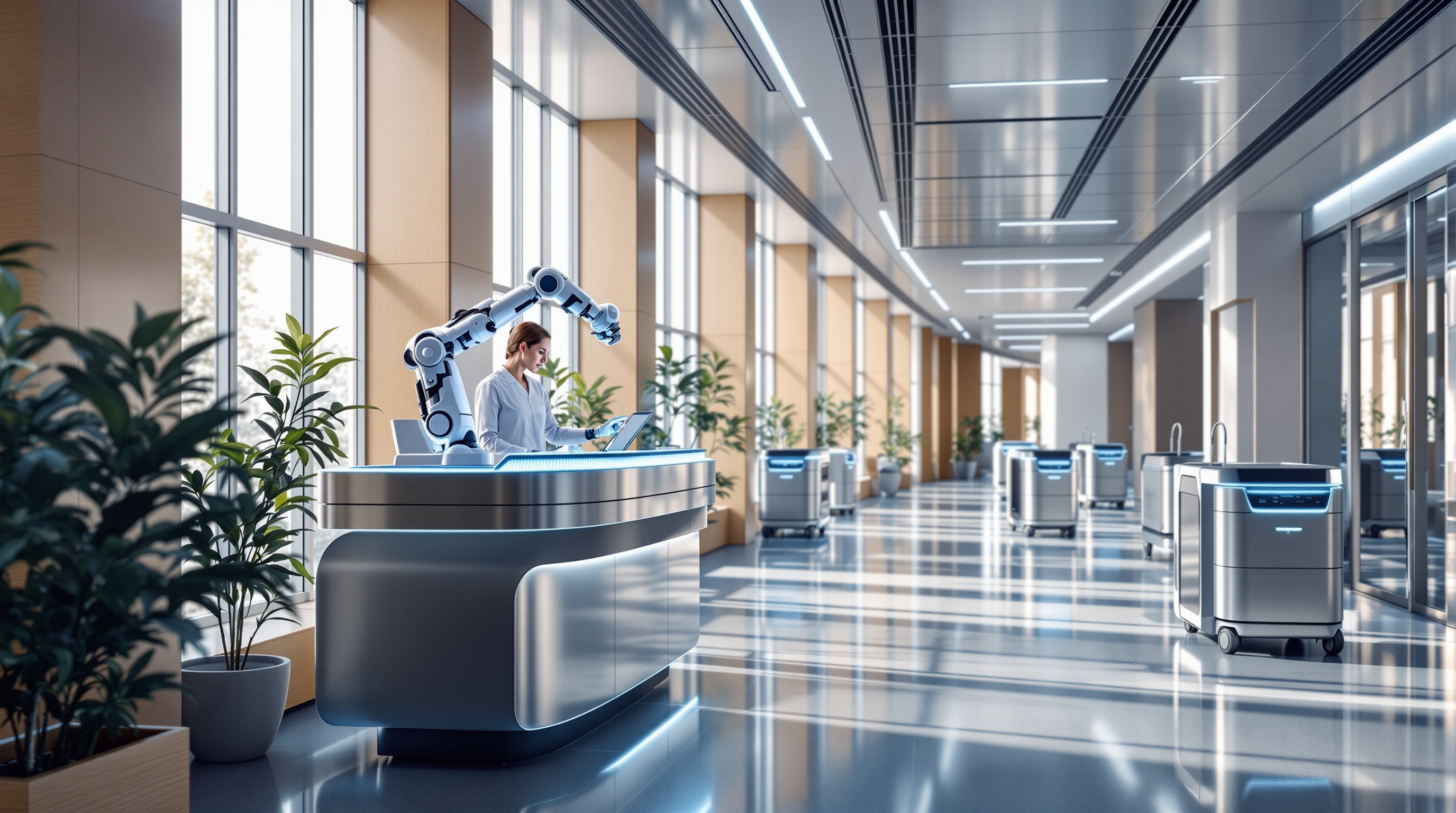Robotic Process Automation in Healthcare for Skilled Nursing
Discover how robotic process automation streamlines skilled nursing facility workflows, boosts efficiency, and improves patient care outcomes.
Quick Navigation
- 1. Introduction
- 2. Current Challenges in Robotic Process Automation Healthcare
- 3. How Sparkco AI Transforms Robotic Process Automation Healthcare
- 4. Measurable Benefits and ROI
- 5. Implementation Best Practices
- 6. Real-World Examples
- 7. The Future of Robotic Process Automation Healthcare
- 8. Conclusion & Call to Action
1. Introduction
Did you know that nearly 94% of skilled nursing facilities report ongoing staffing shortages in 2024? As the aging population grows and the demand for high-quality post-acute care rises, skilled nursing facilities (SNFs) are under immense pressure to do more with less. Frontline staff are stretched thin, administrative teams are buried under mountains of paperwork, and the risk of burnout is higher than ever. The challenge is clear: how can SNFs maintain exceptional patient care and operational efficiency with limited human resources?
Enter Robotic Process Automation (RPA)—a transformative technology that is rapidly making waves across the healthcare landscape. By automating repetitive, time-consuming tasks such as data entry, billing, and scheduling, RPA empowers clinicians and administrators to refocus on what matters most: patient care. Recent studies highlight that RPA and artificial intelligence are not only streamlining operations but also enhancing diagnostic accuracy, improving employee retention, and ultimately elevating the standard of care in nursing homes.
In this article, we’ll explore how RPA is revolutionizing skilled nursing facilities—from real-world examples of automation in post-acute care to the tangible benefits for staff and residents. We’ll also discuss the challenges SNFs face in adopting these technologies and share actionable insights on how to navigate them successfully. Whether you’re an administrator, clinician, or healthcare technology enthusiast, discover how embracing automation could be the key to thriving in today’s ever-evolving skilled nursing environment.
2. Current Challenges in Robotic Process Automation Healthcare
Robotic process automation (RPA) is transforming administrative and clinical workflows in healthcare by automating repetitive tasks and managing vast volumes of data. However, despite its promise, healthcare facilities encounter several significant challenges as they adopt and integrate RPA into their operations. According to Itransition, the healthcare sector’s complexity, stringent regulations, and legacy systems create unique hurdles that must be addressed for RPA to reach its full potential.
-
1. Integration with Legacy Systems
Many healthcare organizations rely on outdated IT infrastructures that were not designed to work with modern RPA tools. Integrating RPA solutions with legacy electronic health records (EHRs) or billing systems can be costly, time-consuming, and fraught with compatibility issues. According to a 2023 HIMSS survey, over 60% of healthcare IT leaders cite legacy system integration as a top barrier to digital transformation. -
2. Data Security and Compliance Risks
Healthcare data is highly sensitive and protected by regulations such as HIPAA. RPA bots that access patient records or billing information must adhere to strict security protocols. Any misconfiguration or lack of oversight can result in data breaches or compliance violations, putting organizations at risk of hefty fines and reputational damage. -
3. Limited Scalability and Flexibility
While RPA can automate rule-based tasks, healthcare environments are dynamic and often require adaptable solutions. RPA bots may struggle with processes that involve frequent changes or exceptions, limiting scalability. A 2022 Deloitte report found that only 25% of healthcare organizations successfully scaled RPA beyond initial pilot phases. -
4. High Initial Investment and Hidden Costs
Implementing RPA involves upfront expenditure for software licenses, integration, training, and change management. Hidden costs, such as ongoing maintenance and bot monitoring, can erode anticipated savings, especially for smaller facilities with limited budgets. -
5. Staff Resistance and Change Management
Healthcare staff may be apprehensive about automation, fearing job displacement or increased complexity in their roles. Successful RPA adoption requires robust change management strategies and ongoing training to ensure staff buy-in and smooth transitions. -
6. Incomplete Process Automation
Many healthcare workflows span multiple departments or involve both digital and manual steps. RPA may automate only parts of a process, leading to fragmented workflows and continued reliance on manual intervention, which can undermine efficiency gains. -
7. Ensuring Patient-Centric Care
Over-automation of administrative processes risks depersonalizing patient interactions. Striking the right balance between efficiency and personalized care is an ongoing challenge, as facilities must ensure that automation does not negatively impact patient satisfaction or clinical outcomes.
The cumulative impact of these challenges can slow RPA adoption, affect operational efficiency, and introduce risks related to compliance and patient care. However, with careful planning, stakeholder engagement, and a focus on robust cybersecurity, healthcare facilities can navigate these obstacles and harness the full potential of RPA. For a deeper dive into RPA challenges and solutions in healthcare, visit Itransition’s comprehensive guide.
3. How Sparkco AI Transforms Robotic Process Automation Healthcare
Robotic Process Automation (RPA) is transforming healthcare by eliminating repetitive manual tasks, but it also introduces unique challenges—such as data silos, workflow integration, maintaining compliance, and ensuring system flexibility. Sparkco AI is purpose-built to address these robotic process automation healthcare challenges, combining artificial intelligence with user-friendly automation to deliver secure, scalable, and efficient solutions. Here’s how Sparkco AI rises to the occasion:
-
Seamless Integration with Existing Systems
Sparkco AI is designed to connect effortlessly with a wide range of healthcare software, electronic health records (EHR), billing platforms, and scheduling tools. This means healthcare organizations can automate processes without costly overhauls or disruptions. The platform’s open architecture ensures new automations work in harmony with legacy systems, reducing IT headaches and accelerating adoption. -
Intelligent Data Processing and Accuracy
Manual data entry is a leading cause of errors and inefficiencies. Sparkco AI leverages advanced AI algorithms to extract, validate, and input information from diverse sources—such as paper forms, emails, or scanned documents—directly into digital systems. This not only decreases human error but also speeds up patient onboarding, claims processing, and reporting. -
Automated Compliance and Security Controls
Maintaining compliance with regulations like HIPAA requires careful handling of patient data. Sparkco AI automates audit trails, enforces access controls, and uses built-in monitoring to detect and prevent unauthorized activities. Automated compliance checks mean staff spend less time on paperwork and more time on patient care, while the system keeps data secure and audit-ready. -
Adaptive Workflow Automation
Healthcare environments and regulations frequently change. Sparkco AI’s flexible automation templates let organizations easily adjust workflows in response to new billing codes, policy updates, or operational needs—without extensive programming. This adaptability ensures automations remain effective as requirements evolve. -
Reduction of Administrative Burden and Staffing Pressures
Staffing shortages and burnout are major pain points in healthcare. Sparkco AI automates time-consuming tasks like appointment scheduling, prior authorization, and claims submission, freeing staff to focus on high-value, patient-facing activities. This not only improves employee satisfaction but also enhances patient experiences. -
Real-Time Analytics and Continuous Improvement
Sparkco AI provides actionable insights through real-time dashboards and analytics, helping organizations monitor process performance and identify further automation opportunities. This data-driven approach ensures ongoing optimization and maximizes the return on investment.
By combining AI-driven intelligence with robust automation, Sparkco AI empowers healthcare organizations to overcome RPA challenges—from integration and compliance to scalability and adaptability. The result: streamlined operations, reduced costs, and more time for what matters most—quality patient care.
4. Measurable Benefits and ROI
Robotic Process Automation (RPA) is rapidly transforming healthcare administration, enabling medical institutions to streamline operations, reduce costs, and improve patient care. By automating repetitive processes such as claims management, patient onboarding, and scheduling, RPA delivers measurable outcomes that directly impact the bottom line. The return on investment (ROI) from RPA in healthcare is compelling, driven by quantifiable benefits across multiple domains.
- Significant Cost Reduction: Healthcare organizations implementing RPA report cost savings ranging from 30% to 50% for automated processes (Itransition). By eliminating manual data entry and reducing resource requirements, RPA minimizes labor costs and operational inefficiencies.
- Time Savings: RPA bots accelerate administrative workflows. For example, claims processing times can be reduced by up to 75%, shrinking from several days to just a few hours (Keragon). Patient onboarding, previously a multi-hour task, can now be completed in under 15 minutes.
- Error Reduction and Data Accuracy: Manual data entry is susceptible to error rates of 4%-5%. RPA reduces this to less than 1%, minimizing costly mistakes in billing and compliance reporting (Innobot Health).
- Improved Compliance: Automated workflows ensure adherence to regulatory standards such as HIPAA by maintaining accurate audit trails and reducing the risk of non-compliance. According to Itransition, RPA-enabled compliance management can decrease compliance-related incidents by up to 80%.
- Faster Revenue Cycle: By streamlining claims submission and follow-up, RPA can shorten the revenue cycle by 20-30%, accelerating reimbursements and improving financial health for providers (CareCloud).
- Enhanced Patient Experience: Automating scheduling and communications reduces patient wait times and administrative friction. Facilities have reported a 30% increase in patient satisfaction scores after implementing RPA in front-office operations (Keragon).
- Scalability and Flexibility: RPA solutions can be rapidly scaled to handle surges in patient data or regulatory changes without significant new hiring or training costs.
- Employee Satisfaction: By offloading repetitive, mundane tasks, RPA enables healthcare staff to focus on value-added activities. Organizations have seen a 20-25% improvement in employee engagement and retention rates (Innobot Health).
The financial and operational impact of RPA is clear. According to Innobot Health, healthcare organizations often achieve ROI within 6 to 12 months of deployment, with ongoing annual savings and performance gains. As healthcare institutions face growing administrative burdens and tighter margins, RPA stands out as a proven, data-driven solution for sustainable efficiency and quality improvement.
5. Implementation Best Practices
Robotic Process Automation (RPA) can revolutionize healthcare operations by streamlining workflows, reducing errors, and freeing up staff for higher-value tasks. However, successful RPA implementation requires a structured approach and mindful change management. Below are seven actionable steps, practical tips, and pitfalls to avoid as you integrate RPA into your healthcare organization.
-
Assess and Prioritize Processes
Identify repetitive, rule-based tasks that consume valuable staff time, such as claims processing, patient scheduling, and data entry. Conduct a process audit to evaluate which workflows will benefit most from automation.
Tip: Start with high-volume, low-complexity tasks to demonstrate early wins.
Pitfall: Avoid automating inefficient or broken processes—optimize them first. -
Engage Key Stakeholders Early
Involve clinical, administrative, and IT teams from the outset. Early buy-in ensures smoother adoption and addresses concerns regarding job roles and data security.
Tip: Establish a cross-functional RPA task force to guide decisions and champion the project.
Pitfall: Don’t underestimate resistance to change—address fears transparently. -
Choose the Right RPA Platform
Evaluate RPA vendors with proven healthcare expertise, robust security features, and seamless integration with existing EHR and billing systems.
Tip: Insist on HIPAA-compliant solutions and request references from similar organizations.
Pitfall: Avoid platforms with limited scalability or weak data protection. -
Design Clear Workflows and Standard Operating Procedures
Map out each automated process in detail, defining inputs, outputs, exceptions, and escalation paths.
Tip: Document every workflow step to ensure clarity and reproducibility.
Pitfall: Overlooking exception handling can lead to costly errors. -
Test Thoroughly Before Full Deployment
Pilot your RPA solution in a controlled environment. Monitor for process accuracy, interoperability, and compliance with data privacy regulations.
Tip: Use test cases that mimic real-world scenarios and edge cases.
Pitfall: Rushing deployment without adequate testing risks patient data and operational stability. -
Train Staff and Foster a Culture of Collaboration
Provide comprehensive training for all impacted employees and communicate the benefits of RPA, emphasizing how it supports—not replaces—their roles.
Tip: Offer ongoing support and a feedback channel for staff.
Pitfall: Neglecting change management can result in low adoption and project failure. -
Monitor, Optimize, and Scale
Continuously track RPA performance with key metrics such as error rates, time savings, and user satisfaction. Refine workflows based on feedback and expand automation to additional processes as confidence grows.
Tip: Schedule regular reviews and engage end-users in process improvement.
Pitfall: Becoming complacent—RPA success depends on continuous improvement.
Change Management Considerations: Successful RPA adoption hinges on transparent communication, leadership support, and a culture that embraces innovation. Address concerns about job security, provide upskilling opportunities, and celebrate early successes to build momentum across your organization.
6. Real-World Examples
Real-World Examples of Robotic Process Automation (RPA) in Skilled Nursing Facilities










